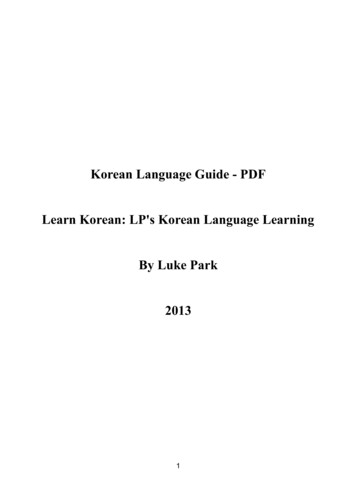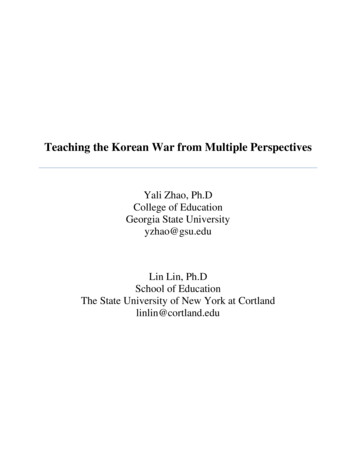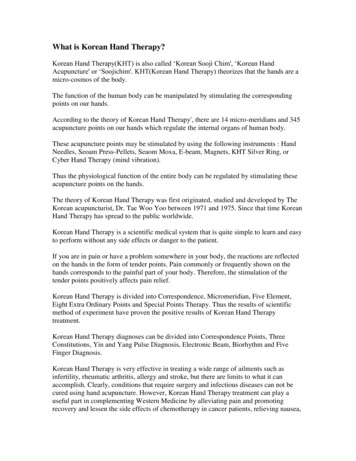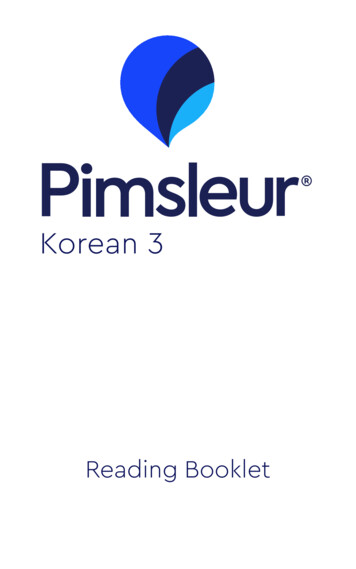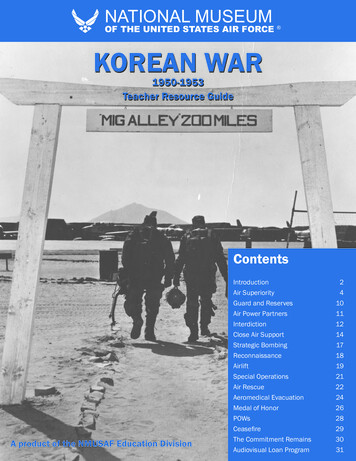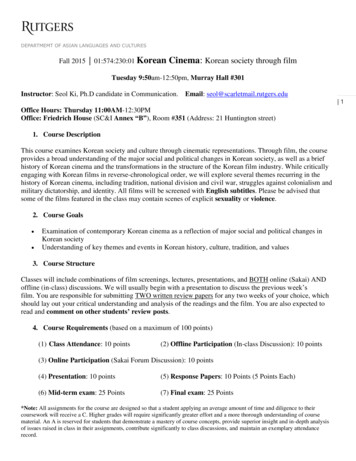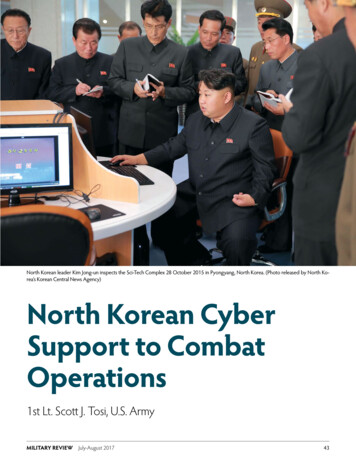
Transcription
DPRK CYBER SUPPORTNorth Korean leader Kim Jong-un inspects the Sci-Tech Complex 28 October 2015 in Pyongyang, North Korea. (Photo released by North Korea’s Korean Central News Agency)North Korean CyberSupport to CombatOperations1st Lt. Scott J. Tosi, U.S. ArmyMILITARY REVIEWJuly-August 201743
As recently as 2014, some Western cyberexperts were describing the cyber capabilitiesof North Korea (the Democratic People’sRepublic of Korea, or DPRK) with apparent indifference, such as Jason Andress and Steve Winterfield inCyber Warfare: Techniques, Tactics and Tools for SecurityPractitioners, who characterized the DPRK’s capability to carry out cyberattacks as “ questionable, but[it] may actually exist.”1 The well-known November2014 cyberattack attributed to the DPRK, executedagainst Sony Corporation as a response to the film TheInterview, helped change perceptions in the UnitedStates of DPRK cyber capabilities—from a minor localnuisance directed at South Korea (the Republic ofKorea, or ROK) to a major global strategic threat.2While the DPRK has been considered a major strategic cyber threat since the attack on Sony, considerationalso should be given to the potential tactical use of cybercapabilities as an extension of its warfighting strategy.objective of the DPRK, according to Korea expert JamesM. Minnich.4 As a 2012 report to Congress pointed out,however, the real purpose of the DPRK’s military policyand political aggressiveness has become to control andsubdue its own population and retain power rather thanto unify the Korean Peninsula.5 Nonetheless, eventssuch as the shelling of Yeonpyeong Island in 2010 andthe exchange of artillery fire in Yeoncheon in 2015have shown that minor provocations have the potentialto erupt into open combat. Moreover, combat couldbecome full-scale war. Whether through accidentalescalation of force or a premeditated surprise invasion,the DPRK may be fully willing to go to war.6Following its failure in the Korean War, the DPRKexpanded and reorganized its military using features ofthe Soviet and Chinese militaries. Subsequently, it hascontinued to draw influence, equipment, and doctrinefrom Russia and China, according to Minnich.7 To avoidthe same fate as the drawn-out invasion of the ROK, the real purpose of the DPRK’s military policy andpolitical aggressiveness has become to control andsubdue its own population and retain power The less familiar tactical use of cyberattacks as a means ofwarfighting poses a greater threat to ROK and U.S. forcesthan any politically motivated strategic cyberattack evercould. The DPRK military’s materiel is considered technologically obsolete at the tactical level. However, evidencesuggests the Korean People’s Army (KPA) will conductcyber operations as an asymmetric means to disrupt enemy command and control and to offset its technologicaldisadvantages during combat operations; therefore, U.S.and partner forces should prepare for this threat.3North Korean Military StrategyTo understand how the DPRK would be likely toconduct tactical cyber operations in support of combatunits during war, it is helpful to consider the historicalaims and presumed military theory of the increasinglyisolated and technologically declining nation. Afterfailing to unify the peninsula from 1950 to 1953, kukkamokp’yo—communization of the ROK, through militaryforce if necessary—became and has remained a primary44the DPRK military appears to have developed a strategyknown as kisub chollyak, which calls for a quick, decisivewar conducted with mixed tactics against ROK andU.S. military forces on the peninsula.8 This approach hasbecome more intransigent over time due to the DPRK’sincreasing economic inability to sustain a protracted war.Therefore, to achieve its tactical objectives as rapidly aspossible, the DPRK has organized its military to initiate combat with “massive conventional and chemicalcannon and missile bombardments while simultaneouslyemploying special operations forces teams,” accordingto Minnich.9 Estimates of the number of DPRK specialoperations forces vary between eighty thousand and onehundred eighty thousand soldiers who could conductasymmetric attacks in the south, intended to enable thelarge-scale light infantry forces that would follow.10Initially, the DPRK likely considered bombardmentand special operations followed by a large-scale invasionforce sufficient to quickly disrupt, confuse, outmaneuver,and overwhelm peninsula-based ROK and U.S. militaryJuly-August 2017MILITARY REVIEW
DPRK CYBER SUPPORTforces before U.S. reinforcements could arrive. However,the strategy faced a shock in the early 1990s after the fallof the Soviet Union and withdrawal of materiel supportthat came from it. This shock no doubt was amplifiedin 1991 by the unexpectedly fast and easy defeat by theUnited States of Saddam Hussein’s Iraqi army, which attempted to employ similar tactics and weaponry againstthe United States as the DPRK had long planned to useagainst the ROK.11 The fall of Hussein’s numericallysuperior army to the U.S. military surely came as a wakeup call to China and the DPRK, which were relying ontechnologically inferior but numerically superior forces tooverwhelm their enemies quickly. Technology was proven superior to overwhelming numbers in force-on-forcecombat. Concurrently, the likelihood that DPRK forceswould be easily overmatched by U.S. technological advantages was accompanied by a rapid decline of the DPRKeconomic and agricultural sectors, which further diminished its ability to project and sustain military forces.12The DPRK’s response to these events included building its nuclear program.13 While U.S. success in OperationDesert Storm implied that the DPRK military could bequickly and decisively defeated by the United States inconventional war, albeit at a potentially high cost of life ofKorean civilians, the DPRK’s nuclear program introduceda high risk of mass destruction of ROK and U.S. targets,should the United States or the ROK provoke war.Notwithstanding, while the development of anuclear deterrence option supported defensive politicalgoals for the DPRK, it did little to advance the prospectof kukka mokp’yo. For that, the DPRK seems to haveemulated China’s apparent doctrinal changes made inthe wake of Desert Storm.After the United States defeated the Iraqi army—thefifth largest in the world in 1990—in just five weeks, theChinese military apparently reevaluated its warfightingstrategy and tactics.14 In the 1990s, China developed astrategy of hybrid warfare that relied on relatively cheaptechnological methods for negating the United States’qualitative military superiority through indirect attacks.In 1999, evidence of the Chinese military’s new approachappeared in Unrestricted Warfare: China’s Master Plan toDestroy America (an English summary translation basedon a 1999 publication by two Chinese army colonels),which described using several asymmetric measures todefeat the United States, including conducting information warfare aimed at negating the U.S. military’s visibilityMILITARY REVIEWJuly-August 2017of the battlefield through all means necessary.15 Nationalsecurity scholars Richard A. Clarke and Robert Knakeassert that this strategy has resulted in China’s adoption oflarge-scale cyberwarfare, which would include the stealingof technological information and the tactical targetingof intelligence, reconnaissance, and surveillance assets toequalize the battlefield in any force-on-force action.16Believing its nuclear program would deter attackson its homeland, and having survived the economic andagricultural crisis of the 1990s, the DPRK faced a dilemma in the early 2000s similar to what China faced in thewake of the Gulf War, when it became apparent thatChina would be vulnerable to defeat by advanced U.S.weapons technology. The DPRK’s general response to thisdilemma was threefold: increasing the number of specialoperations forces to conduct unconventional warfare,expanding its electronic warfare and signals intelligenceassets to conduct jamming operations, and, most important, creating tactical and strategic cyber operations underwhat are known as Bureau 121, No. 91 Office, and Lab110.17 As with any aspect of the DPRK, it is difficult toverify information about these secretive organizations.North Korean Cyber OrganizationIt is reported that Bureau 121, No. 91 Office, andLab 110 are components of six bureaus under theReconnaissance General Bureau (RGB) that specializesin intelligence gathering under the administration of theGeneral Staff Department1st Lt. Scott J. Tosi,(GSD). While the GSDU.S. Army, is the executiveis responsible for theofficer for A Company,command and control of310th Military Intelligencethe KPA, it falls underBattalion, 902nd Militarythe Ministry of People’sIntelligence Group. HeArmed Forces (MPAF),previously served asaccording to Andrewthe executive officerScobell and John M.for Headquarters andSanford.18 This arrangeHeadquarters Company,ment would give the RGB501st Military Intelligencedirect operational controlBrigade out of Yongsan,from the top of the chainKorea. He holds a BS inof command and ensurehistory and social sciencesthe cyber componenteducation from Illinois Statecould conduct operationsUniversity, and he taughtindependently and inhigh school history and civsupport of the KPA basedics in Bloomington, Illinois.on operational need.45
Bureau 121 reportedlycomprises an intelligence-gathering component and an attack component. The unit isthought to operate primarilyout of Pyongyang as well as theChilbosan Hotel in Shenyang,China.19 No. 91 Office is believedto operate out of Pyongyang toconduct hacking operations forthe RGB.20 Lab 110 is believedto conduct technical reconnaissance, infiltration of computernetworks, intelligence gatheringthrough hacking, and plantingviruses on enemy networks.21While there appear to benumerous other cyber organizations in the DPRK, those outside the RGB primarily pertainto internal political control orspreading political propagandato foreign nations. Therefore,their work relates little to tactical or operational cyber supportfor combat operations.Estimates of the size of theDPRK’s cyber force have rangedfrom as few as 1,800 hackers andcomputer experts to nearly sixthousand, which would make itthe third largest cyber agency behind the United States and Russia.22 The higher estimatereportedly came from ROK intelligence early in 2015, butthe number cannot be verified. Moreover, it was unclearwhether No. 91 Office and Lab 110 were included in thecalculation, but given the ROK’s desire to influence theUnited States to consider DPRK cyber threats a priority,it is likely their strength was included (some consider theROK estimates inaccurate due to bias). Furthermore,the ROK’s estimate represents 2013 data and, like muchintelligence on North Korea, is already out of date.Irrespective, the shortage of concrete knowledge ofDPRK cyber organizations is compounded by the natureof DPRK’s Internet access. The DPRK has divided itsnetworks into two components. Only government andmilitary agencies can access the outward-facing network46North Korean army hackers are widely reported to work in the Chilbosan Hotel (photographed here 17 April 2005), partly owned by theNorth Korean government, in Shenyang, China. Such reports are plausible due in part to the apparent advantages of working from China,such as the ready availability of multiple lines of communication, not tomention modern equipment, training, logistical support, and a reliablesource of power. (See, for example, James Cook, “PHOTOS: Inside TheLuxury Chinese Hotel Where North Korea Keeps Its Army of Hackers,”Business Insider website, 2 December 2014, accessed 12 June -hotel-where-northkorea-keeps-hackers-2014-12). (Photo by tack well, Flickr)routed through China, which hackers use for conductingcyberattacks. The other component is the kwangmyong,a monitored intranet of government-selected content.23As of January 2013, one “Internet café” was reportedJuly-August 2017MILITARY REVIEW
DPRK CYBER SUPPORTin the DPRK, in Pyongyang, where citizens reportedlyconduct only small-scale reconnaissance and testing ofcan access only the kwangmyong.24 The use of Chinesemethodologies on enemy networks. This approach wouldnetworks to access the global Internet provides a buffermitigate the risk of enemies developing countermeasuresfor DPRK hackers tothat would compromisedeny responsibility foradvantages the DPRKtheir intrusions andwants to maintain forattacks. Moreover,full-scale war.they can safely conductAlthough U.S. andoutbound attacks whilepartner forces knowavoiding inbound atrelatively little about thetacks from the ROK orDPRK’s cyber capabilthe United States.25ities, China and RussiaHowever, use ofcan be studied as models.third parties for outChina, as North Korea’sward Internet accessclosest (and perhapsalso makes DPRK cyonly) ally, provides notber operations reliantonly outward-facingon continued coopernetworks for Northation from China andKorean cyber units butother partners. Despitealso bases of operations,waning support for thesuch as the Chilbosanisolated state in recentHotel, and training.years, China’s supportKnown Chinese cyberseems assured duringactions have primarilypeacetime. However,focused on technologicalit is not guaranteed ifespionage, something thewar breaks out.DPRK probably has littleSince the low levelinterest in as it lacks theof connectivity funcinfrastructure to build orA satellite image of North Korea compared to South Korea at night. Technological backwardness reportedly compels North Korean army hackerstions as protectionmaintain suchastheChilbosanHotelinfrom outside attacks,advanced weaponry asChina, where access to technology and communications lines is readilythe DPRK can focusChina does. In contrast,available to conduct cyberattacks. (Image courtesy of NASA)on developing offensiveRussia’s cyber activitiescyber capabilities. Fewduring its 2008 invasionDPRK systems or networks if compromised wouldof Georgia and 2014 military action in Ukraine suggestreduce warfighting capabilities.26 The high-profilethe DPRK’s likely tactical cyber actions in the event ofcyberattacks attributed to DPRK hackers have servedwar on the Korean Peninsula.largely strategic and political purposes. However, cyberNorth Korean Tactical Cybersupport to combat units in the event of full-scale warSupport to Warfightinglikely remains a key component of a DPRK strategy.While a land, air, and sea war on the KoreanCyberwarfare is unique in that once a new methodPeninsula would commence, or escalate, at a specificology or technique has been used in an attack, the victimdate and time, the cyber war would begin long beforecan create countermeasures relatively quickly to preany shots were fired.27 While, arguably, the cyber warvent future attacks. Probably for this reason the DPRKwith the DPRK is already ongoing, it would need tohas not, and most likely would not, conduct large-scaleincrease the frequency and intensity of cyber recontactical or operational cyberattacks on the ROK or thenaissance and attacks before a general war in order toUnited States unless at war. Rather, the DPRK wouldMILITARY REVIEWJuly-August 201747
successfully support conventional combat units. In thelead-up to war and early stages of war, North Koreanasymmetric cyber units would target civilian communications through simple denial of service.In 2008, Russia preceded its attack on Georgia withdistributed denial of service (DDOS) attacks for weeksbefore Russian soldiers crossed the border to test theircapabilities and conduct reconnaissance on Georgiannetworks, planning to attack them again later. Russiaattacked Georgian communications, crippling the government’s ability to communicate and coordinate againstRussian forces.28 The Russian cyberattacks combinedsimplicity with sophistication in execution; they allowedRussia to cheaply take down Georgian command andcommunications. What would have taken days, if notweeks, of bombing and coordination between intelligence and air power took minutes from the safety ofRussian computers but achieved the same result. U.S.and partner forces can reasonably expect that as a technologically inferior nation with an obsolete air force andnavy, the DPRK would conduct similar attacks.Furthermore, the DPRK appears to have demonstrated such capability. From 2014 to 2016, the DPRKreportedly hacked “more than 140,000 computers” in theROK belonging to government and businesses, and ittried to attack the ROK transportation system’s controlnetwork.29 The attacks, likely carried out by Bureau 121,enabled the DPRK to gain access to and monitor ROKgovernment and business communications.If this had occurred during an invasion, the DPRKmight have turned off all 140,000 computers, rendering these organizations’ communications defunct. Itmight have been able to shut down or desynchronizethe ROK transportation network.If increased in scope and aggressiveness, such attackscould cut the ROK’s communication and information-sharing capabilities with the military. Conductedin conjunction with special operations forces destroying physical communications systems in the ROK, theDPRK might disable ROK and U.S. communications,leaving units on the battlefield blind. Cutting communications in the early stages of the war would cripple theROK and U.S. ability to coordinate artillery and aerialassets, giving DPRK forces time and space to overwhelmROK and U.S. forces in the demilitarized zone.While targeting of communications and criticalnetworks in the ROK would hamper ROK and U.S.48efforts, alternative means of communication might stillenable the two nations to counter the DPRK’s aggression. However, vital secondary means of communicationcould be neutralized by targeting the ROK power grid,potentially negating the ROK and U.S. advantages overDPRK forces by slowing a timely coordinated response toaggression. Several years ago, such an attack would havebeen deemed impossible for a nation as technologicallybackward as the DPRK. Today, such an attack by theDPRK in the event of war is almost certain.For example, in December 2015, Russian hackerscaused a power outage in Ukraine via cyberattack. Theyinstalled malware on Ukraine’s power plant network andremotely switched breakers to cut power to over 225,000people.30 Russia then swamped Ukrainian utility customerservice with fake phone calls to prevent the company fromreceiving customer calls.31 Given the level of sophisticationthat DPRK cyber units seem to have reached and the relationship the DPRK maintains with Russia, it is likely thatthe DPRK has received support from Russia for potentially conducting similar attacks against ROK power plants.Cyberattacks, in essence, would be an asymmetric approach to compensate for the DPRK’s almost nonexistentair force. They could inflict tactical and operational damage on the ROK to enhance the “shock-and-awe” bombardments that likely would precede military intervention. Byknocking out critical communications, transportation, andsupport infrastructure, the DPRK would cause confusionand disorder that would facilitate its conventional infantryforces’ overwhelming ROK and U.S. forces.Nevertheless, while these methods could be effective, it is unlikely Bureau 121 would be able to fullytake the ROK network offline, although a fractionalnetwork disruption could severely hinder ROK andU.S. actions on the battlefield. To fully negate ROKand U.S. technological superiority, the DPRK wouldneed to employ more sophisticated cyberattacksagainst GPS, radar, logistics support systems, andweapons targeting systems. Exactly how the DPRKwould conduct such attacks is outside the scope of thisdiscussion. The threat should be taken seriously, however, as the Defense Science Board warns, “should theUnited States find itself in a full-scale conflict with apeer adversary, U.S. guns, missiles, and bombs maynot fire, or may be directed against our own troops.Resupply, including food, water, ammunition, and fuelmay not arrive when or where needed.”32July-August 2017MILITARY REVIEW
DPRK CYBER SUPPORTHacking or taking radar and GPS offline, if even forseveral days before ROK and U.S. forces could recover,could ground air power, offering DPRK units freedom ofmaneuver on the battlefield. Moreover, the disruption ofGPS would not only negate the use of GPS-guided weapons systems, but, more dangerously, it could also causeweapons to fire at incorrect coordinates. The hacking ofU.S. satellites, which China reportedly has already shownit can accomplish, could blind ROK and U.S. intelligenceto DPRK movements on the ground.33If the DPRK hacked automated logistical networksthat supported ROK and U.S. forces on the peninsula,those forces would have difficulty sustaining warfighting capabilities. Tracking, requisitioning, and deliveringessential war supplies could be disrupted by a simpleDDOS attack that would shut down systems or corruptdata, causing logistical supplies to be sent incorrectly. ROK and U.S. soldiers could quickly find themselveswithout the resources necessary to fight.Therefore, the DPRK could use cyberattacks to ensureits numerical superiority and overwhelming volume offirepower could triumph despite inferior materiel. WhenMILITARY REVIEWJuly-August 2017Students work at computers 13 April 2013 at Mangyongdae Revolutionary School in Pyongyang, North Korea. The school is run by themilitary, and school administrators say it was originally set up in 1947for children who had lost their parents during Korea’s fight for liberation from its Japanese occupiers. (Photo by the Associated Press)combined with electronic warfare and special operationsforces acting behind the battle lines, this would, consistent with the ideals in Unrestricted Warfare, cause ROKand U.S. forces to lose momentum and maintain a defensive and reactionary posture.Unrestricted Warfare describes the “golden ratio” andthe “side-principal” rule. The idea is that the golden ratio,0.618 or roughly two-thirds, which is usually applied toart, architecture, and mathematics, can be applied towarfare. The authors point out that once the Iraqi armywas reduced by the U.S. Air Force to 0.618 of its originalstrength, it collapsed and the war ended.34 The side-principal rule, in essence, is the idea that war can be wonthrough nonwar actions. When taking these two theoriestogether, it becomes apparent that while the Chinese may49
believe they could not defeat the United States in warthrough conventional combat, they probably believe theycould defeat the United States if nonwar actions wereused to diminish the U.S. military’s strength to aroundtwo-thirds of its combat power.For China, the options for achieving this are numerous, as China has increasing resources it can draw uponto carry out nonwar actions for extended periods, be theycyber, financial, or political. For the DPRK, with its goalof kukka mokp’yo and its extremely limited resources,the options are fewer. The DPRK likely would translatethe golden ratio and side-principal rule into diminishingROK and U.S. forces through cyberattacks, combinedwith numerous other asymmetric means, by one-third.With their systems taken offline or corrupted, U.S. andROK warfighting capabilities would be diminished ordisrupted to a point where, theoretically, the DPRK armycould launch a massive ground invasion. Cyberattack,therefore, is a means by which the DPRK likely wouldstrike at enemy warfighting support systems, thereby giving its numerically superior military the space, time, andfreedom of maneuver to sustain a fight on the peninsula.A cyberattack could include a nuclear-detonatedelectromagnetic pulse that would disable electronic devices within a 450-mile radius.35 The DPRK could, theoretically, achieve this by detonating a nuclear device inthe atmosphere at an altitude of thirty miles. This attackcould negate technological advantages of friendly forceson the peninsula, rendering equipment with an electroniccomponent useless. However, given the threat of nuclearretaliation as well as the increased likelihood of U.S. support of a prolonged war, which would most likely result inthe DPRK’s defeat, this option probably would remain alast resort short of a tactical nuclear strike.Solutions to Counter North KoreanCyber CapabilitiesNorth Korean leadership likely believes the DPRKcould revert the tactical balance of power to thatof the 1950s, using its cyber capabilities to gain anadvantage. In June 1950, U.S. tactical ground forceswere embarrassingly defeated by a numerically superior enemy that was less trained, less equipped, andthought to be less prepared for war. As the UnitedStates continues to withdraw permanent combat unitsfrom the ROK and revert to a support role, leaving itsforces on the peninsula unprepared to mount a majordefense, the United States should take action to avoidfinding itself in a situation similar to 1950.DPRK cyber capabilities are not without their vulnerabilities. In 2014, in retaliation for the Sony hacks, theUnited States conducted a DDOS attack on the DPRKthat took the kwangmyong offline.36 This attack, however,did not retaliate against the cyber units, mostly operatingout of China, but instead took the intranet offline. Thisevent highlights a major vulnerability of the DPRK ina time of full-scale war. DPRK cyber operability likely would be at the mercy of the Chinese government.Should the Chinese government decide the continuedsupport of the DPRK was politically unsustainable, theDPRK’s cyber capability could become marginalized.To mitigate the risk of DPRK cyber threats, Armyassets must actively partner with ROK forces and reassess the way they view cyber operations. As a preventivemeasure, Army cyber assets must monitor U.S. networkswithin the ROK and networks of units scheduled to deploy to the ROK, as these units are the most likely to betargeted by DPRK assets. Rather than actively neutralizeidentified DPRK cyber threats, Army leaders must assessthe intelligence benefits gained by allowing adversarieslimited freedom of action in order to study their tactics,techniques, and procedures in the cyber domain.Army leaders should begin studying cyber operationsas a force multiplier from both an offensive and defensivevantage, and not as a discipline outside the tactical oroperational domain. Additionally, Army forces stationedin the ROK should develop contingency plans with ROKforces anticipating DPRK cyberattacks similar to thoseoutlined in this article, and they should train in environments shaped by cyberwarfare. In this way, U.S. andSouth Korean forces could mitigate the significant threatposed by North Korean cyber forces.Notes1. Jason Andress and Steve Winterfield, Cyber Warfare: Techniques,Tactics and Tools for Security Practitioners, 2nd ed. (Waltham, MA:50Syngress, 2013), 73. Andress and Winterfield cite Jung Kwon Ho, “Meccafor North Korean Hackers,” Daily NK online, 13 July 2009.July-August 2017MILITARY REVIEW
DPRK CYBER SUPPORT2. Clyde Stanhope, “How Bad is the North Korean Cyber Threat,”Hackread website, 20 July 2016, accessed 2 May 2017, an-cyber-threat/; Office ofthe Secretary of Defense (OSD), “Military and Security DevelopmentsInvolving the Democratic People’s Republic of Korea: 2015,” A Reportto Congress Pursuant to the National Defense Authorization Act forFiscal Year 2012, accessed 4 May 2017, ilitary and Security Developments Involving the Democratic Peoples Republic of Korea 2015.PDF.3. James M. Minnich, The North Korean People’s Army: Origins andCurrent Tactics (Annapolis, MD: Naval Institute Press, 2005), 68.4. Ibid.5. OSD, “Military and Security Developments Involving theDemocratic People’s Republic of Korea: 2012,” A Report to CongressPursuant to the National Defense Authorization Act for Fiscal Year2012, 15 February 2013, accessed 6 May 2017, http://archive.defense.gov/pubs/Report to Congress on Military and Security Developments Involving the DPRK.pdf.6. Daniel Wagner and Michael Doyle, “Scenarios for Conflict Betweenthe Koreas,” Huffington Post, 25 February 2012, accessed 2 May cenarios-for-conflict-be b 1169871.html.7. Minnich, The North Korean People’s Army, 53–54.8. Ibid., 73.9. Ibid., 73–74.10. Ibid.; Blaine Harden, “North Korea Massively Increases Its SpecialForces,” Washington Post website, 9 October 2009, accessed 3 May article/2009/10/08/AR2009100804018.html; OSD, “Military and Security DevelopmentsInvolving the Democratic People’s Republic of Korea: 2015.”11. Joseph Bermudez, North Korea’s Development of a NuclearWeapons Strategy (Washington, DC: US-Korea Institute at SAIS[ Johns Hopkins School of Advanced International Studies], August2015), accessed 4 May 2017, 6/02/NKNF Nuclear-Weapons-Strategy Bermudez.pdf.12. Ibid.13. Ibid.14. James M. Broder and Douglas Jehl, “Iraqi Army: World’s5th Largest but Full of Vital Weaknesses,” Los Angeles Times online, 13 August 1990, accessed 8 May 2017, http://articles.latimes.com/1990-08-13/news/mn-465 1 iraqi-army.15. Richard A. Clarke and Robert Knake, Cyber War: The NextThreat to National Security and What to Do about It (New York: HarperCollins, 2010), 28–29; Qiao Liang and Wang Xiangsui, UnrestrictedWarfare: China’s Master Plan to Destroy America, summary translation(Panama City, Panama: Pan American Publishing, 2002).16. Clarke and Knake, Cyber War, 30–32.17. Harden, “North Korea Massively Increases Its Special Forces”;Stanhope, “How Bad is the North Korean Cyber Threat.”18. Andrew Scobell and John M. Sanford, North Korea’s MilitaryThreat: Pyongyang’s Conventional Forces, Weapons o
DPRK CYBER SUPPORT North Korean Cyber Support to Combat . 1st Lt. Scott J. Tosi, U.S. Army North Korean leader Kim Jong-un inspects the Sci-Tech Complex 28 October 2015 in Pyongyang, North Korea. (Photo released by North Ko-rea's Korean Central News Agency) . high school history and civ-ics in Bloomington, Illinois. 46 July-August 2017 .

